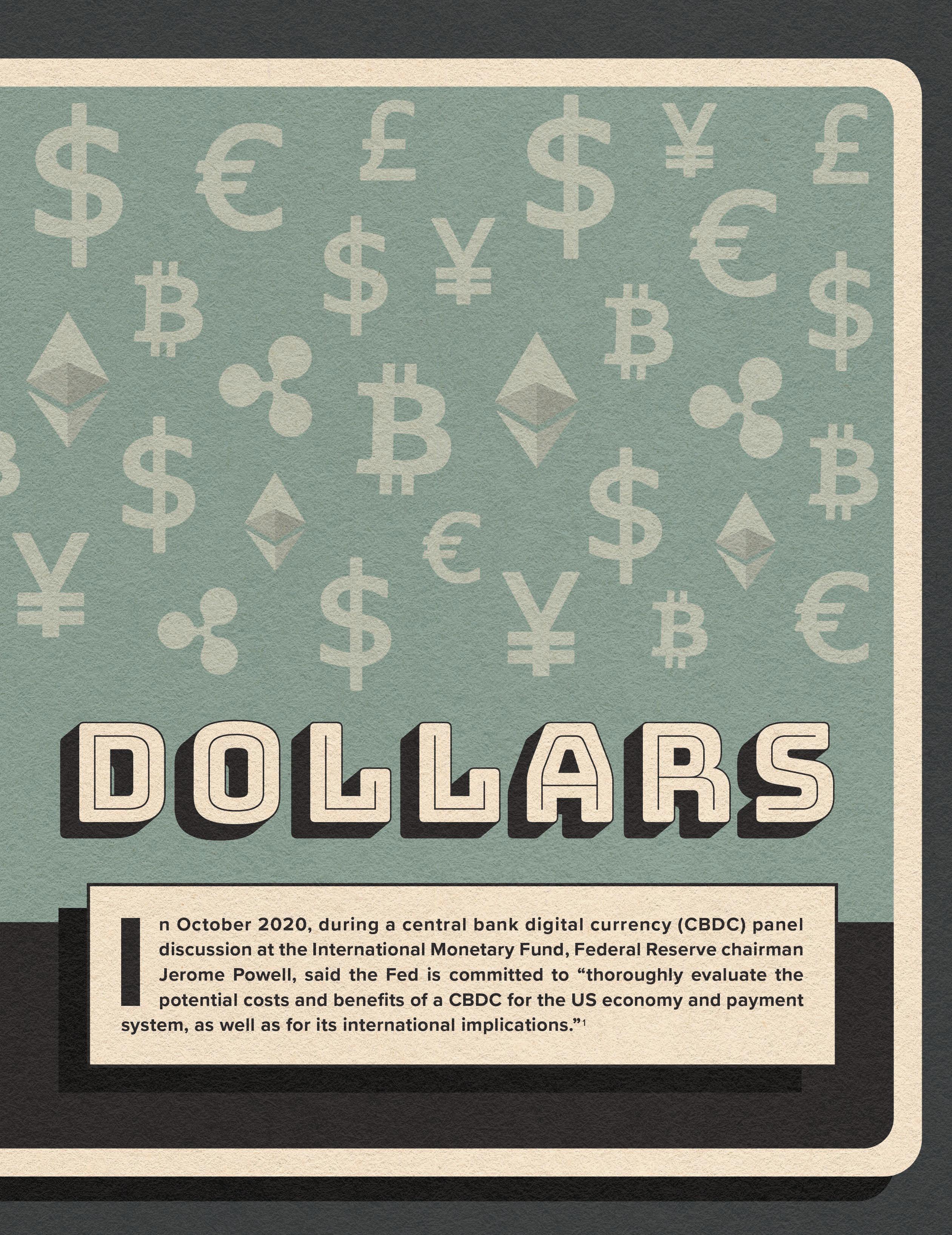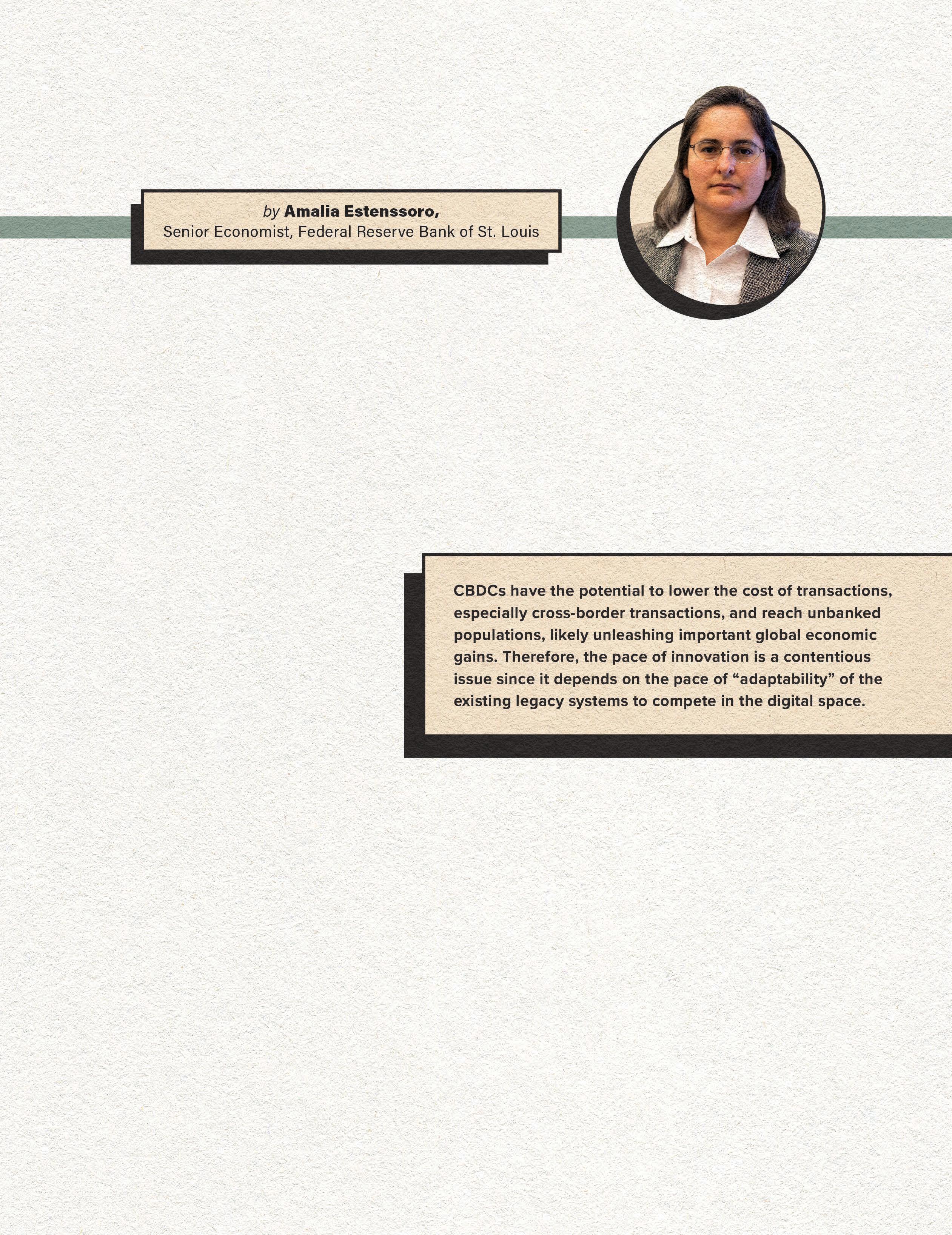
6 minute read
Digital Dollars

Such concerted digital technology awareness from major central banks only dates back to June 2019, when Facebook published its first white paper on its “Libra”4 project that took monetary authorities by surprise. Though modified, a Libra stablecoin retains strong network medium of exchange capabilities given its 1.8 billion global Facebook users.5 Central banks have taken notice and are assessing the risks. They have also committed to be at the forefront of technological and monetary innovation to ensure efficient payments and safeguarding financial stability. Ultimately, central banks will have to decide if the new technology will be launched by the private sector, as was the case in China6, or by central banks via technological innovation in the form of digital “public money” (i.e. CBDCs).
The issuance of a CBDC is a sovereign decision, as it introduces a third “central bank money” or “public liability” into an economy; besides cash that is used by the public at large, and reserves that are exclusively used by banks. A “retail” CBDC will compete with cash and regulated private money (bank deposits), and will be used by the public as a medium of exchange with legal tender properties in a sovereign jurisdiction. Any commitment to launch a CBDC will depend on country-specific circumstances, such as: the demand for cash in the economy; the development of its banking and payment systems; and, the desirability, or willingness, to increase access to central bank liabilities beyond just banks, to non-banks, or the public at large.
CBDCs, as an equivalent of cash, will become a new digital option to hold money. In the absence of a CBDC for transactional purposes, digital transactions almost always settle in the two-tier (bank) payment rails that deliver “finality” of payment and credible convertibility into cash.7 The usefulness of the regulated two-tier payment system rests on the necessity to minimize fraud, crime, and financial instability in the economy. CBDCs, on the other hand, have the potential to lower the cost of transactions, especially cross-border transactions, and reach unbanked populations, likely unleashing important global economic gains. Therefore, the pace of inno“THE ISSUANCE OF A CBDC IS A SOVEREIGN DECISION, AS IT INTRODUCES A THIRD “CENTRAL BANK MONEY” OR “PUBLIC LIABILITY” INTO AN ECONOMY...”

1 In the Federal Reserve System, the Boston Fed has partnered with the MIT to develop templates for a potential US CBDC, in case the Fed decides to launch one, or Congress legislates one should be launched. 2 Since late 2019, the BIS Innovation Hub project has formed, or is about to form, multidisciplinary teams located in Hong Kong, Singapore, Switzerland, Toronto, London, Frankfurt/Paris, Stockholm, and New York, with different jurisdictions’ central banks. 3 Stablecoins are private, non-bank, digital liabilities, 100% backed by high quality liquid assets, and convertible 1:1 into cash. 4 Libra first proposal was as a multi-currency “floating coin.” It was later modified into separate (reserve currencies) “stable coins.” A dollar stablecoin could be launched as soon as in 2021 (Financial Times), and it will be convertible 1:1 on demand. Libra is operating under a new name (Diem white paper introduction). 5 Tech giants have obtained very fast, large economies of scale when entering other sectors in the economy. By entering the financial sector, these companies could very rapidly concentrate systemic risk as non-regulated financial firms. 6 In China, Alipay and Tenpay benefited from light regulation from 2004-2017 to grow their digital liabilities exponentially. Authorities have just introduced heavy regulation, including future market share caps, ahead of its own CBDC launch. Alipay (54% market share) and Tenpay (39% share, combining WeChat Pay and QQWallet) dominate the largest global mobile payment market. 7 Even if a transaction is done electronically, the settlement has to go through banks and central bank balance sheets to finally clear and settle irrevocably. Prudential bank supervision and regulation, as well as deposit insurance, were put in place to maintain the public confidence that bank deposits will always be convertible to cash 1:1 on demand, up to a statutory limit. In the US, the Federal Depository Insurance Corporation guarantees up to $250,000 per account.
vation is a contentious issue since it depends on the pace of “adaptability” of the existing legacy systems to compete in the digital space. In this context, a CBDC could be an innovation catalyst.
Nonetheless, digital progress is gradually being introduced into the payment system, as non-bank digital companies acquire bank charters, or partner with existing banks to provide digital payments. Simultaneously, in the US, the Fed is developing the FedNow Service with a target release date of 2023 or 2024. FedNow is a retail instant payment system that will allow for more aggressive digital competition in the marketplace, while updating the existing two-tier payment system for retail immediacy (24x7x365) in clearing and settlement. Updated “real-time payment” systems could be an intermediary stage before a CBDC, while unintended monetary and credit implications of launching a new type of public money is better researched and understood.
In the US, global demand for dollar notes and coins continues to increase, reaching $2 trillion in circulation at the end of 2020, of which half is held outside of the country. Moreover, the dollar remains the major global reserve currency. The dollar retains this status as a key mechanism to store value due to the US’ transparent, open, and deep financial markets, which makes it even more important to fully understand the “trade-offs” that digital technology can provide when designing a CBDC. To summarize, Chairman Powell stated, “it is more important to get it right, than get it first.” More generally, the BIS has highlighted the “public good” aspect of central bank services, which include the provision of sound money and safe payments. In this context, CBDCs might turn out to be the most effective way to use new technology to attain such goals.
That is why, the BIS, in late 2020, published its first report stating central banks’ “common motivation” for exploring CBDCs, while remaining fully

committed to providing cash. The BIS and global central banks generally agree that, at a minimum, CBDCs should promote innovation and efficiency, without compromising monetary or financial stability, as well as offer future “interoperability” in cross-border transactions. Nonetheless, CBDCs have the potential to disturb the demand for cash, the demand for bank deposits, and the equilibrium of credit provisioning in the economy, leading to important trade-offs. Central banks will need to fully understand these trade-offs before deciding to launch a CDBC in their respective jurisdictions.
8 Designing Central Bank Digital Currency, I. Agur, A. Ari, G. Dell’Arriccia, IMF WP/19/252 9 In October 2020, the first “live” retail CBDC, the Sand Dollar, was launched in the Bahamas. Besides, only China has firmly committed to launch a CBDC as soon as in 2021, and the Chinese authorities are not part of the BIS Innovation Hub. Since 2020, Chinese authorities have been live-testing, in four mainland cities, Digital Currency/Electronic Payments (DC/EP), a retail “hybridCBDC,” which is a CBDC-managed through the banking system that deals with customer accounts, but is a central bank liability, instead of a bank liability.










